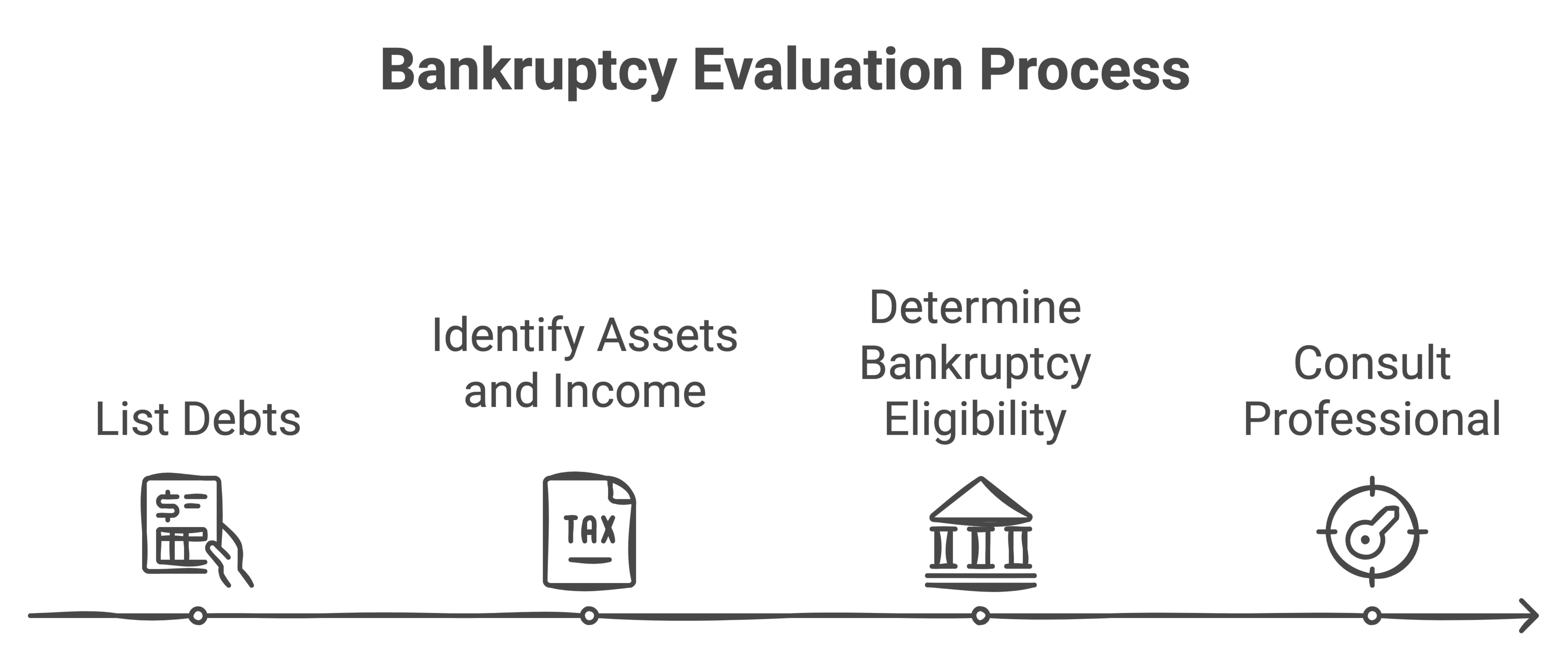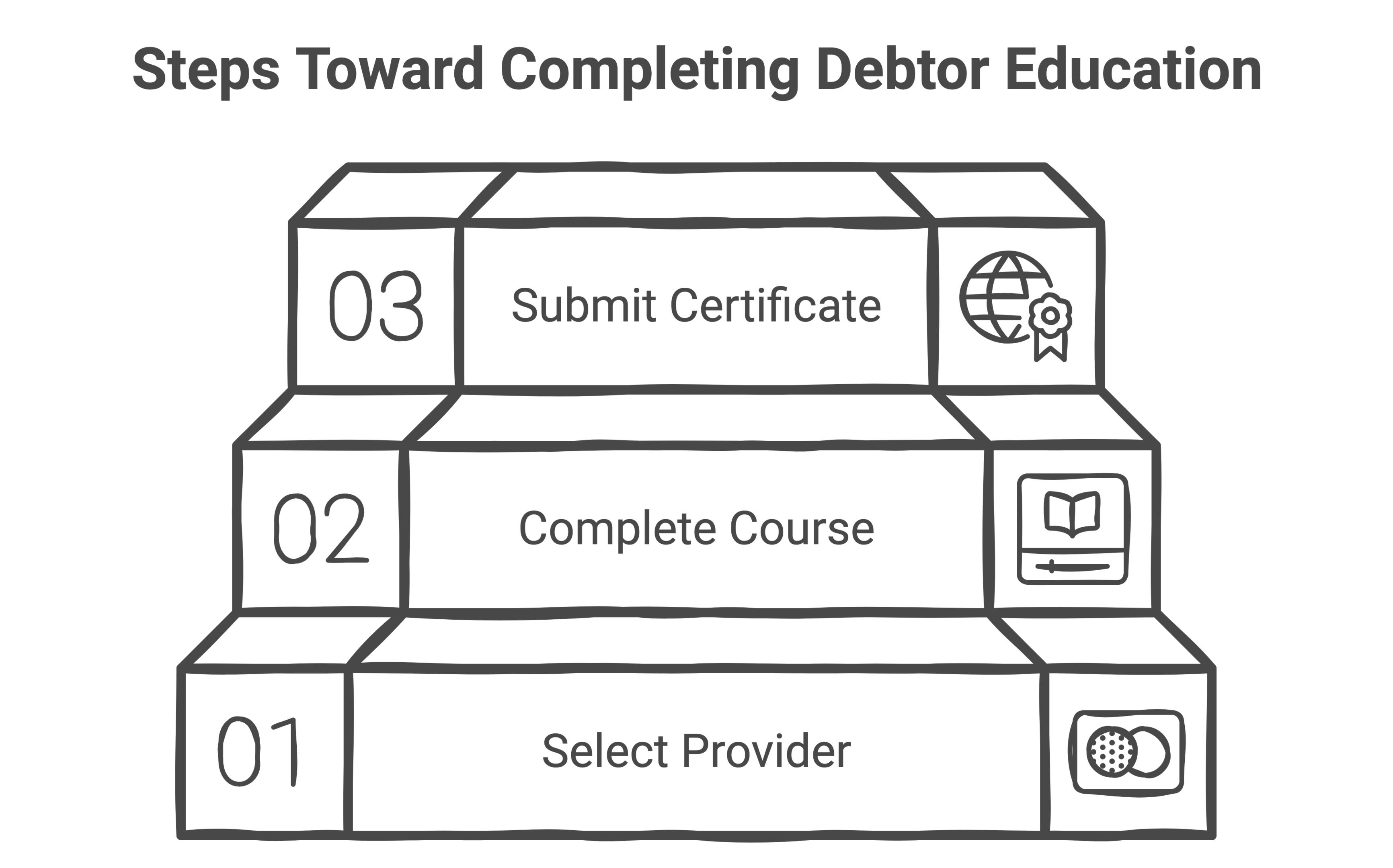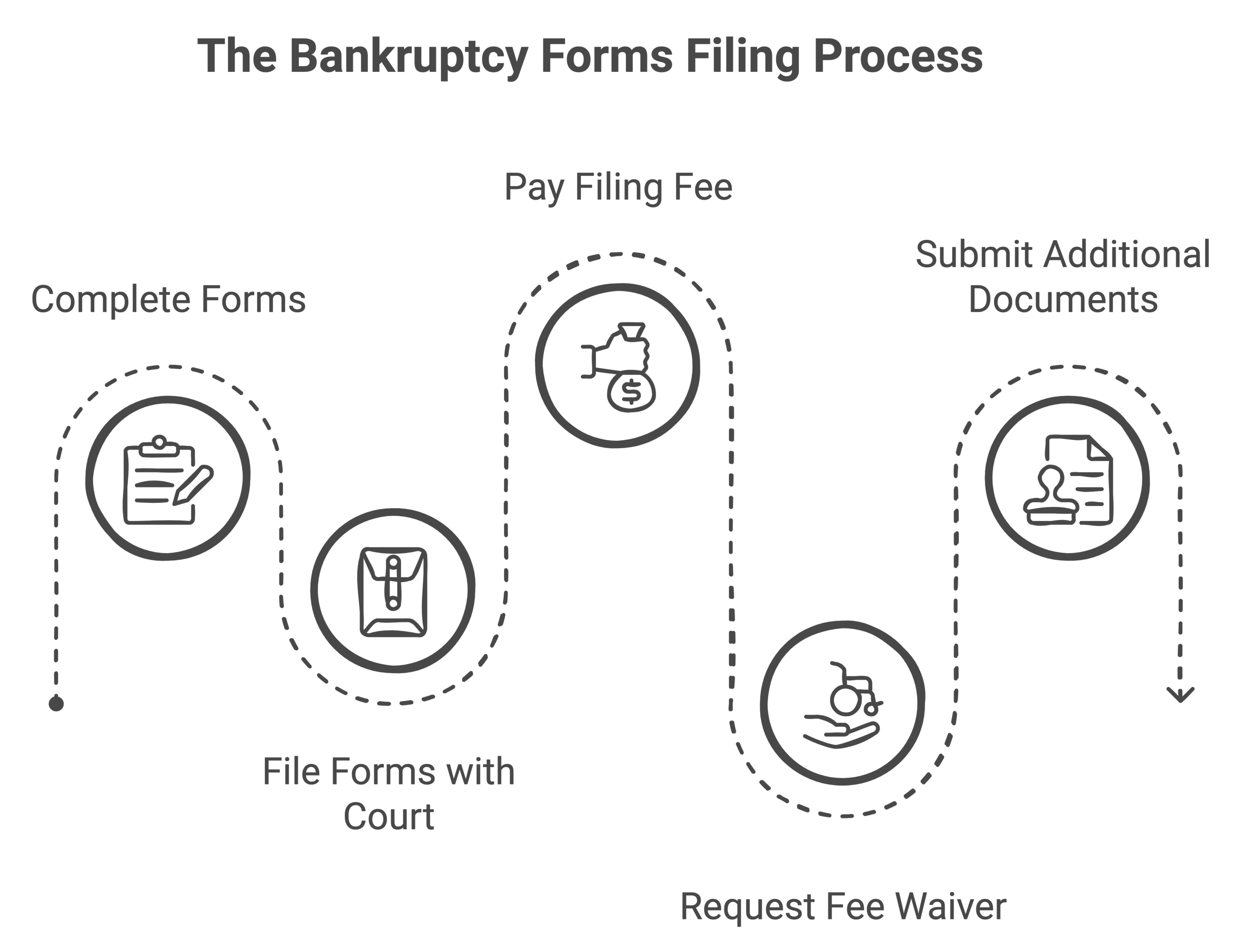If you’re overwhelmed by debt, you may wonder, “How do I file for bankruptcy?” Here’s a step-by-step guide to help you get started.
To file for bankruptcy, complete pre-bankruptcy credit counseling, consult an attorney, gather financial documents, pass a means test (if applicable), file bankruptcy forms with the court, attend a 341 meeting of creditors, and complete a post-filing debtor education course.
With decades of experience guiding clients through bankruptcy, our team at DebtBusters simplifies the process, ensuring you feel supported and informed at every stage. Below, we break down each step to help you take control of your financial future.

Step 1 – Assess Your Financial Situation and Bankruptcy Options
Before filing, it is essential to assess your financial situation and understand which type of bankruptcy might be best suited to your needs. This self-assessment will help you make an informed decision about how to proceed.
Types of Bankruptcy
Chapter 7 Bankruptcy involves liquidation of non-exempt assets to pay off unsecured debts. It is suitable for individuals who do not have the means to repay their debt. Filing under Chapter 7 is typically faster, taking three to six months to complete, and discharges most unsecured debts.
Steps to Decide Which Bankruptcy to File
- List all debts, including the type of debt, balance, and interest rate.
- Identify your assets, monthly income, and living expenses.
- Determine if you are eligible for Chapter 7 based on your income, or if a Chapter 13 repayment plan is more feasible.
- Consider consulting a bankruptcy attorney or financial counselor to gain clarity and evaluate the best option for your situation.

Step 2 – Complete Credit Counseling
Before filing for bankruptcy, the government requires that you complete a credit counseling course. This counseling session is mandatory and must be completed within 180 days before filing.
How to Complete Credit Counseling
- Locate a credit counseling agency approved by the U.S. Trustee Program. You can find a list on the official U.S. Trustee website.
- Attend the session, which takes one to two hours and can be completed online or by phone.
- Obtain the certificate of completion, as this will need to be submitted with your bankruptcy forms.
Credit counseling provides an opportunity to review alternative debt relief options and confirm that bankruptcy is the right choice.
Step 3 – Gather Required Documentation
Bankruptcy involves submitting detailed information about your financial situation to the court, so gathering necessary documents early can save time and reduce stress during the filing process.
Documents You Will Need to Provide
- Recent tax returns and W-2 forms or 1099s
- Bank statements for all accounts
- Proof of income, such as recent pay stubs
- A list of monthly living expenses, including rent, utilities, and groceries
- Documentation for all assets and debts, including any outstanding loans or credit card balances
Organizing these documents in advance ensures you can accurately complete your bankruptcy forms and avoid potential delays in processing your case.
Step 4 – Complete Bankruptcy Forms and File with the Court
Filing for bankruptcy involves filling out multiple forms that detail your finances. These forms are the foundation of your bankruptcy case and must be filed accurately.
Key Bankruptcy Forms to Complete
Voluntary Petition initiates your bankruptcy case and formally declares your intent to file for bankruptcy.
Schedules A-J document your assets, liabilities, income, expenses, and other financial details.
Statement of Financial Affairs provides a snapshot of your recent financial history, including income sources and asset transfers.
Steps for Filing Bankruptcy Forms
- Complete all required forms carefully, ensuring accuracy.
- File the forms with your local bankruptcy court and pay the filing fee. If you are unable to afford the fee, you may request a fee waiver.
- Submit any additional state-required documents as part of your bankruptcy filing.
Comparing Key Bankruptcy Forms
| Form Name | Purpose |
|---|---|
| Voluntary Petition | Officially starts the bankruptcy process |
| Schedules A-J | Lists assets, debts, income, and expenses |
| Statement of Financial Affairs | Outlines recent financial history |
Filing these forms accurately is crucial, as they establish the foundation of your case and help the court understand your financial situation.
Step 5 – Automatic Stay Goes Into Effect
Once you file for bankruptcy, an automatic stay goes into effect immediately. This stay is a legal protection that temporarily halts most collection activities against you.
What the Automatic Stay Covers
- Foreclosures are put on hold, giving you time to consider how to handle any pending home payments.
- Wage Garnishments are paused, allowing you to keep your income while the bankruptcy case is processed.
- Creditor Calls and Collection Efforts must cease, relieving you of frequent collection communications.
The automatic stay provides immediate relief and is a valuable protection for individuals facing urgent financial strain. However, it is essential to continue your responsibilities during the stay, as it is temporary.
Step 6 – Attend the Meeting of Creditors
After you file for bankruptcy, you will be required to attend a meeting of creditors, commonly referred to as a 341 meeting. This meeting provides an opportunity for the bankruptcy trustee and any creditors to ask questions regarding your financial circumstances and verify the accuracy of the documentation you submitted.
What to Expect During the 341 Meeting
- The meeting typically lasts about 10-15 minutes.
- You will be asked to verify your identity with a photo ID and Social Security card.
- The trustee will ask questions about your financial situation, debts, and property to confirm the details provided in your bankruptcy filing.
- Creditors rarely attend this meeting, but if they do, they may ask questions related to specific debts.
This meeting is an essential part of the bankruptcy process and ensures transparency. Having your paperwork organized and being prepared to answer questions helps the meeting proceed smoothly.
Step 7 – Complete Debtor Education and Receive Your Discharge
The final step in the bankruptcy process is completing a debtor education course, which aims to provide you with financial management skills to support your fresh start. This course must be completed after filing but before the court grants a discharge of your debts.
Steps to Complete Debtor Education
- Select an approved course provider through the U.S. Trustee Program.
- Complete the course, which usually takes about two hours and is available online.
- Submit your completion certificate to the court.

Once you complete the course and the court reviews your case, eligible debts will be discharged, officially freeing you from the financial obligations included in the bankruptcy filing. This discharge marks the beginning of your new financial start.
Comparison of Chapter 7 and Chapter 13 Bankruptcy
Each type of bankruptcy offers unique benefits depending on your financial situation. The table below compares essential features to help you determine which option may be best.
| Feature | Chapter 7 | Chapter 13 |
|---|---|---|
| Type | Liquidation | Repayment Plan |
| Eligibility | Income below certain threshold | Requires steady income |
| Duration | 3-6 months | 3-5 years |
| Asset Protection | Limited | Allows retention of more assets |
| Discharge Type | Most unsecured debts | After completing repayment plan |
This comparison highlights the key differences between Chapter 7 and Chapter 13 to help you decide which path best suits your financial needs.
Take the First Step Toward a Debt-Free Future
Filing for bankruptcy can be challenging, but it offers a pathway to financial relief and peace of mind. With guidance and support, you can confidently complete each step and regain control over your finances.
If you are ready to explore how bankruptcy can help you start fresh, call DebtBusters at (866) 223-4395 for professional assistance tailored to your situation. Our experienced team is here to help you every step of the way.
Frequently Asked Questions
What is the difference between Chapter 7 and Chapter 13 bankruptcy?
Chapter 7 bankruptcy involves the liquidation of non-exempt assets to eliminate most unsecured debts. It is typically faster and suited for individuals with limited income or assets. Chapter 13 bankruptcy establishes a repayment plan over three to five years and allows individuals with steady income to retain certain assets.
How much does it cost to file for bankruptcy?
Filing fees for bankruptcy vary but generally cost around $338 for Chapter 7 and $313 for Chapter 13. Attorney fees may also apply. If you cannot afford the fees, you may request a fee waiver from the court.
How long does bankruptcy stay on your credit report?
Chapter 7 bankruptcy remains on your credit report for 10 years, while Chapter 13 bankruptcy stays for 7 years. Both impact your credit, but most individuals can start rebuilding their credit within a few years.
Will all my debts be discharged in bankruptcy?
Not all debts are discharged in bankruptcy. Student loans, certain taxes, child support, and alimony are typically non-dischargeable. However, unsecured debts such as credit card debt and medical bills are generally eligible for discharge.
What is an automatic stay and how does it protect me?
An automatic stay is a legal order triggered upon filing for bankruptcy that temporarily halts most collection efforts, including creditor calls, wage garnishments, and foreclosures. It provides immediate relief while the bankruptcy case is being processed.
Is credit counseling mandatory for filing bankruptcy?
Yes, credit counseling is required by law and must be completed within 180 days before filing. This step ensures that you are aware of all options and that bankruptcy is the most appropriate solution for your financial situation.
Can I keep my home and car if I file for bankruptcy?
he ability to keep your home or car depends on the type of bankruptcy you file and the amount of equity in your assets. Chapter 13 allows individuals to keep their home and car through a structured repayment plan, while Chapter 7 may require selling non-exempt assets.







